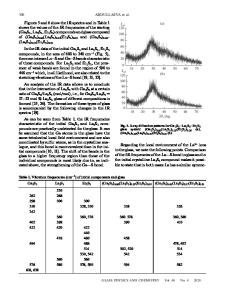Enhancement on Charge Generation and Transfer Properties of Sb 2 S 3 Quantum-Dot-Sensitized Solar Cells by ZnO Nanorods
- PDF / 2,645,494 Bytes
- 8 Pages / 593.972 x 792 pts Page_size
- 26 Downloads / 448 Views
https://doi.org/10.1007/s11664-020-08542-8 Ó 2020 The Minerals, Metals & Materials Society
Enhancement on Charge Generation and Transfer Properties of Sb2S3 Quantum-Dot-Sensitized Solar Cells by ZnO Nanorods Optimization ZHUOYIN PENG,1,3 ZUOQIU NING,1 ZHOU LIU,1 JIANLIN CHEN,1 WEI LI,1 WEI QIU,1 JIAN CHEN,1 and YUTING TANG2,4 1.—Key Laboratory of Efficient and Clean Energy Utilization, The Education Department of Hunan Province, Hunan Province 2011 Collaborative Innovation Center of Clean Energy and Smart Grid, School of Energy and Power Engineering, Changsha University of Science and Technology, Changsha 410111, People’s Republic of China. 2.—Sinohydro Engineering Bureau 8 Co., LTD, Changsha 410111, People’s Republic of China. 3.—e-mail: [email protected]. 4.—e-mail: [email protected]
ZnO nanorod films prepared using different electrochemical deposition processes have been employed as photoelectrodes for Sb2S3 quantum-dot-sensitized solar cells. The density and diameter of the ZnO nanorods were adjusted by varying the electrochemical deposition time. The optical absorption and photoluminescence spectra of the different Sb2S3-sensitized ZnO nanorod photoelectrodes were investigated, revealing that the best optical absorption and charge separation properties were exhibited by the Sb2S3-sensitized ZnO nanorod photoelectrodes obtained using an electrochemical deposition time of 120 min. The charge transfer property of the quantum-dot-sensitized solar cells was also optimized by using ZnO nanorods with different structures. The Sb2S3-based quantum-dot-sensitized solar cells based on the ZnO nanorod photoelectrodes with relatively high density and low diameter fabricated using a deposition time of 120 min exhibited excellent charge generation and transfer properties, enabling higher current density and thereby a photovoltaic power conversion efficiency of 2.04%. Key words: ZnO nanorods, density and diameter, charge generation and transfer properties, Sb2S3 quantum-dot-sensitized solar cells
INTRODUCTION With the development of the solar cell industry, many kinds of novel solar cells such as Cu2ZnSnS4 thin-film solar cells and perovskite solar cells have been investigated by researchers to reduce the final production cost of electrical power.1–6 However, problems with efficiency and stability still limit their development for use industrial use. Quantum dots (QDs), which offer the advantages of low cost, easy preparation, high stability, size effect, ultrafast
(Received July 6, 2020; accepted September 30, 2020)
electron transfer, and multiple exciton generation, have been employed as sensitizers or absorbers in the fabrication of quantum-dot-sensitized solar cells (QDSSCs).7–10 Over the last decade, many investigations have focused on the preparation, structure, and surface states of QDs in solar cells, thus achieving high photovoltaic conversion efficiency values.11–13 However, a large gap remains to the theoretic photovoltaic efficiency of QDSSCs. Meanwhile, the toxic elements used in some QDs and the stabil
Data Loading...











